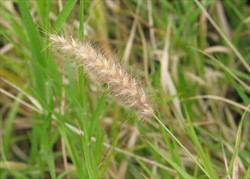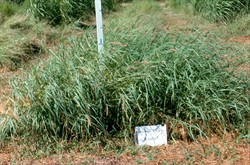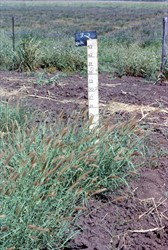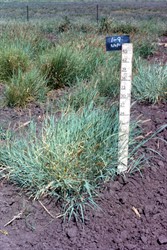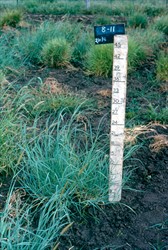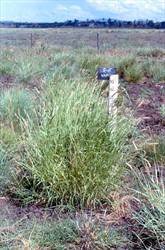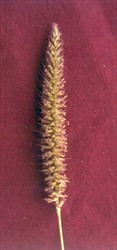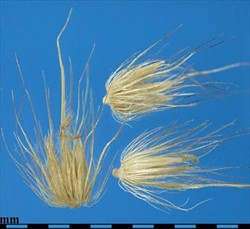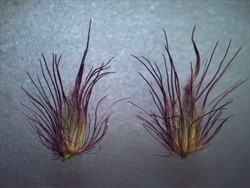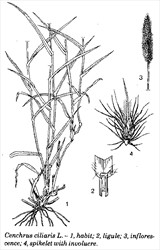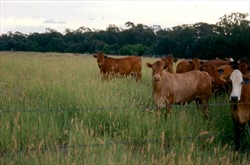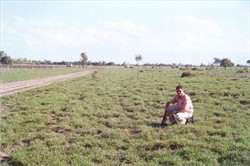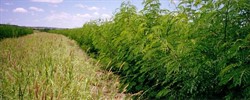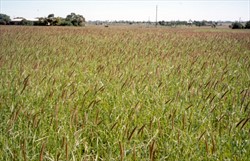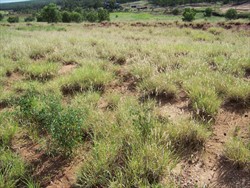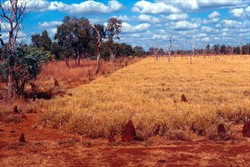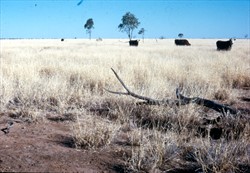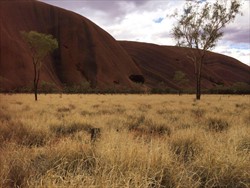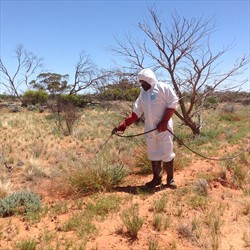Cenchrus ciliaris
Tropical Forages
Cenchrus ciliaris L.
Cenchrus glaucus C.R. Mudaliar & Sundararaj; Pennisetum cenchroides Rich.; Pennisetum ciliare (L.) Link; Pennisetum incomptum Nees
Family: Poaceae (alt. Gramineae) subfamily: Panicoideae tribe: Paniceae subtribe: Cenchrinae.
Extremely variable species, tufted (sometimes shortly rhizomatous) perennial, with types ranging in habit from ascendant to erect, and branching culms from about 0.3 to 2.0 m at maturity; rooting at lower nodes. Root system strong, fibrous, to >2 m. Stems wiry, 1–4 mm thick, nodes hairy or glabrous. Leaves basal and cauline. Ligule a fringe of hairs, 0.2–2 mm long. Leaf blades linear, 2–13 mm wide and 3–37 cm long; apex acuminate; green, blue green to grey green in colour, scabrous, mostly glabrous, sometimes hairy at the base. Inflorescence erect or nodding spiciform panicle, 2–15 cm long and 1–2.6 cm wide, straw, grey or purple coloured, bristly, with numerous bur-like seed units (fascicles) inserted along a zig-zag axis. Fascicle comprising 1–4 spikelets, 2–5.5 mm long, acutely lanceolate, surrounded by an involucre of bristles; involucral bristles deciduous with the fertile spikelets; with an outer whorl of thinner bristles; inner bristles longer than outer; with one conspicuously longer bristle; 8–16 mm long; bristles antrorsely barbed and hairy, giving the fascicle an adhesive quality. Caryopsis obovoid; dorsally compressed; 1.5–2 × 1 mm; dark brown; glabrous; truncate or obtuse; apex unappendaged. 330,000–550,000 seed units/kg, or 900,000–2,000,000 caryopses/kg.
Similar species
C. pennisetiformis: inner bristles of the involucre united for 1–3 mm above the base.
C. ciliaris: inner bristles of the involucre united at the base only.
Africa: bloubuffel(gras), breëblaar(gras), buffelsgras, pokogras, donkiegras, drooglandgras, droëland(e/s)gras, katstert, katstertbuffel, katstertgras, katstertjie, klebgras, litjiesgras, pêrelmanne, skaapgras (Afrikaans); |uiobageda, |hoobe |gâ.n, |huru |gâ.n (Damara); matagudeesa (Ethiopia); diilaleesa (Gabra); haufato (Hausa); orurenda (Herero); g|uril|'a-n||ae (-si) (Ju|'hoan, Namibia); |gâ.n, |hoobe, |huru, |uiobageda (Khoekhoegowab); enkopikedongoi, oloju (Maasai); ebanau, ebeno, habinni, heskanit, labdi, lahbdi (Mali); el-labd, kra’legrâb, bûrgîba, bu rgiba, bou-er-rgueba, tabat d-did, tâbat ed-dîb, sebet-ed-dib (Morocco); chiundo (Mozambique); habini, massinguié, tabahot (Niger); karangiyaa, karangiyar, nijibi (Nigeria); kandjata (Rukwangali); diam hamham, ngolo (Senegal); molekangwetsi, modikangwetsi (Setawana); agar, anodug, arapsur, baldhoole-cagaar, ciir dhuuq, garrow, gudomad, gurde agar, harfo, irdug, lyah makarri (Somalia); modula-tjava, se-be-kxare-ya-weso (Sotho); danab el kalib; haskanit naim, heskanit (Sudan); amerukwa (Turkana); in tungamusi, se-be-kxare-ya-weso (Zulu)
Arabic: aebaed; gharaz; heskanit; khaȡir (Qahtan); sabta; thumúm (Bani Hajir); darab, sabat (Qatar)
Asia: 水牛草 shui niu cao (Chinese); higekurinoiga (Japanese); kawit-kawitan, sagisi (Philippines); ya bup fen (Thailand)
English: African foxtail grass, buffel grass, buffelgrass, foxtail grass, foxtail buffalo grass, blue buffalo grass
Europe: svinehale (Danish); cenchrus cilié (French); Büffelgras, Blaubüffelgras, Fuchsschwanz, Katstert (German)
India: aajan grass, anajan, andho, angan, anjan, anjana, baiba, bandri, bharbhunt, charwa, dhaman, dhamanio, dhamman, handri, jiral, kollukattai, koluk katai, kolukkattai pul, kurkan, kusa, marwar anjan, roondar dhaman, saféd-dhãman, taura, vaghnoru
Latin America: capim-búfel (Brazil); pasto buffel; zacate buffel (Mexico)
Native:
Africa: Angola; Botswana; Djibouti; Egypt; Eritrea; Ethiopia; Ghana; Kenya; Libya; Malawi; Mali; Morocco; Mozambique; Namibia; Niger; Nigeria; Senegal; Somalia; South Africa (Eastern Cape, Free State, Gauteng, KwaZulu-Natal, Limpopo, Mpumalanga, North West, Northern Cape, Western Cape); Sudan; Swaziland; Tanzania; Tunisia; Uganda; Zambia; Zimbabwe
Asia: Afghanistan; ndia; Iran; Iraq; Israel; Jordan; Oman; Pakistan; Saudi Arabia; Sinai (Egypt); Syria; Yemen
Europe: Sicily
Indian Ocean: Madagascar.
Macaronesia: Madeira Islands (Portugal); Canary Islands (Spain)
Naturalized:
Widely naturalized and cultivated in sub-humid and semi-arid tropics and subtropics
Forage
Mainly used as a permanent pasture, but can be used for hay or silage. Not suited to short-term pasture because too difficult to remove and binds nutrient.
Environment
C. ciliaris is very effective in binding soil in semi-arid regions.
Other
It has also been used in folk medicine for a variety of conditions.
Soil requirements
Often occurs in the wild on sandy soils, but is also well adapted to deep, freely draining sandy loam, loam, clay loam and red earth soils. Although slow to establish on black cracking clay soils, once established it grows well. Requires good fertility, particularly with respect to N, P and Ca. Available P levels should be >10 mg/kg and total N levels >0.1%. The optimum soil reaction is pH 7‒8, but grows on soils with pH as low as 5.5. Very sensitive to high levels of soil aluminium and manganese. Apart from soil depth, rooting depth is also limited by high subsoil salinity or sodicity and low pH (<5). However, moderately tolerant of salinity, but less so than Chloris gayana .
Moisture
The most drought tolerant of the commonly sown grasses, Cenchrus ciliaris occurs naturally in areas with average annual rainfall from as low as 100 mm up to about 1,000 mm, but most commonly between 300 and 750 mm. Under cultivation, it has been grown in areas with rainfall as high as 2,900 mm, although this is exceptional. Winter rainfall should be <400 mm. Does not survive prolonged waterlogging, particularly in cold season, but can stand up to 5 days of flooding with negligible adverse effect. Losses of 15‒70% occur after 20 days of flooding. Tolerance of flooding varies with ecotype, the taller varieties appearing to be more flood-tolerant.
Temperature
Found from about 33º S in South Africa to about 35º N in Syria and 37º N in Sicily, and from sea level to 2,500 m asl. This equates to a distributional range of the species over regions with average annual temperatures from about 12 to 28 ºC. Optimum temperature for photosynthesis in varieties measured is 35 ºC, and minimum between 5 and 16 ºC. Relative growth rate rises steeply from 15/10 to 30/25 ºC, with a small further increment to 36/31 ºC. Some varieties are better adapted to cooler environments than others. Winter survival varies with ecotype, some surviving to -7 ºC. Tops are killed by frost but plants mostly recover with resumption of warmer conditions. In general, performs best in areas where mean minimum winter temperatures are >5 ºC.
Light
Intolerant of shade.
Reproductive development
An early flowering short day plant with an optimal photoperiod of 12 hours. Flowering time varies among ecotypes.
Defoliation
Slow to establish and grazing may need to be delayed 4‒6 months after sowing, and up to 9‒12 months, depending on establishment conditions. Very tolerant of regular cutting or grazing. Since quality declines rapidly with age, should be cut or grazed at least every 8 weeks. Leafiness is maintained by low cutting at about 7 cm.
Fire
Very tolerant of, and favoured by fire. Cover of Cenchrus ciliaris can increase, and populations of associated fire-susceptible species decrease in a fire regime. Fire is often prescribed at 1‒3 year intervals to maximize productivity and nutritional content of C. ciliaris as a forage, and to control establishment of woody plants.
Guidelines for establishment and management of sown forages.
Establishment
Fresh seed often has high level of dormancy. Germination rate can be improved with storage of 6‒18 months after harvest or by separating caryopses from other "seed unit" components. Total live seed content is commonly 30‒50%. Establishment is difficult on hard setting and heavy clay soils. Establishes readily if competition is controlled. Sown 0‒1 cm deep at 1‒2 kg seed/ha, the lower rate on sandy-loam soils. The fluffy seed can cause bridging problems in mechanical planters, although pelleting can improve flow of seed. Best sown through a roller drum, grass airseeder, modified fertilizer spreader or modified combine. Mixing with fertilizer, cracked grain, or using pelleted seed improves distribution through airseeders and combines. Sow at and rely on follow-up rain for establishment. Can also be established vegetatively from "splits".
Fertilizer
Establishment fertilizer is rarely necessary since Cenchrus ciliaris should only be sown on fertile soils. However, phosphorus may be necessary, especially if sowing with a legume. Stands become unproductive with time as nitrogen is tied up in the root system. It is generally not economical to apply nitrogen fertilizer to overcome this situation, but management techniques include use of legumes (see Companion species: Legumes below) or limited cultivation to release mineral N from the soil organic matter every 3‒5 years.
Compatibility (with other species)
Cenchrus ciliaris is a particularly aggressive grass, by virtue of its extensive root system competing with associated species for water and nutrients. It also appears to be allelopathic (suppression of other species by exudation of phytotoxic chemicals that inhibit germination and growth of other plants).
Companion species
Grasses: Chloris gayana, Digitaria eriantha, D. milanjiana, Megathyrsus maximus cv. Petrie.
Legumes: Desmanthus leptophyllus, D. virgatus[1] [2] [3], D. bicornutus, Leucaena leucocephala, Macroptilium atropurpureum, Stylosanthes hamata, S. scabra, S. seabrana.
Pests and diseases
The most serious disease is buffel grass blight caused by the fungus, Magnaporte grisea (anamorph Pyricularia grisea), a rampant leaf spot disease that reduces quality and production of forage and seed, and in some cases, destroys stands. Pyricularia grisea is a highly variable pathogen and differential responses have been found to occur, with some varieties of C. ciliaris being resistant to the various races of the pathogen. Other fungal species causing damage are Fusarium oxysporum, Bipolaris sp., and Claviceps sp. Alternative host for Claviceps fusiformis is pearl millet (Cenchrus americanus).
Seed crops can be reduced by buffel grass seed caterpillars (Mampava rhodoneura) that feed on seed, webbing the heads together. Can be controlled by spraying crops with methomyl 10 days after heads emerge.
Ability to spread
Spreads readily by seed, which is well adapted to dispersal by wind or water movement. Seed also moved by livestock through adhesion to fur, or through ingestion and defecation. No natural spread on soils of pH <7, even though establishment with cultivation is possible on these soils.
Weed potential
Invasive in arid and semi-arid environments, and has been declared noxious in some areas due to its threat to biodiversity conservation. In its native range, C. ciliaris has been reported as a weed of chickpea (Cicer arietinum), cotton (Gossypium spp.), potato (Solanum tuberosum) and maize (Zea mays).
Nutritive value
CP values are mostly in the range of 6‒16%, and IVDMD and CP digestibility from 50 to 60%, depending on age of growth, cultivar, and soil fertility (incl. fertilizer use). P levels are usually higher than in other tropical grasses and range from 0.15 to 0.65% in the DM.
Palatability/acceptability
Generally less palatable than Panicum coloratum and Megathyrsus maximus but more palatable than Setaria incrassata.
Toxicity
Oxalate levels can cause 'big head' (Osteodystrophia fibrosa) in horses, and oxalate poisoning in young or hungry sheep. However, with soluble oxalate levels of 1‒2% in the DM, there is rarely a problem with mature ruminants.
Feedipedia link
Dry matter
Yields depend greatly on soil fertility and growing conditions, but are mostly in the range of 2‒9 t/ha DM, and under ideal conditions, up to 24 t/ha DM.
Animal production
Can carry up to 1 steer or 6 sheep/ha, depending on rainfall and soil fertility. Cattle can gain up to 180‒200 kg/hd/yr at 2 ha/beast on fertile soils under good growing conditions.
An extremely variable polyploid species. Most ecotypes are obligate apomicts although facultative apomicts that require pollination only for endosperm initiation, also exist. A unique sexual mutant from a USA population has been used in plant breeding programmes. Tetraploid is the most common chromosome complement, 2n = 4x = 36; also find plants with 2n = 5x = 45, 6x = 54 and rarely 7x = 63, as well as aneuploids, 2n = 29, 30, 32, 34, 38, 40, 42, 44, 48, 50, 52 and 56.
Good seed yields are obtained by maximizing the number of fertile culms (tillers), the length of the inflorescence, the number of fertile spikelets per fascicle, and the number of caryopses set. The seed crop is initiated by first defoliating the stand, either mechanically or by grazing. Low cutting (scalping) results in more vigorous tillers, whereas cutting even at 15 cm can result in profuse, less vigorous aerial tillering. Nitrogen is essential for seed production, yields being raised 10-fold and more with nitrogen fertilizer, usually at rates of 100 or 200 kg/ha N. The need for higher levels of nitrogen increases with the age of the stand as available soil nitrogen becomes bound up in the extensive fibrous root system. Soil phosphorus levels should also be maintained. In more tropical environments, three crops per year can be achieved, depending on cultivar and adequacy of soil moisture, irrigated dry season yields often being greater than wet season yields. Seed can be sequentially hand or machine stripped on a rotational basis as seed matures. It normally takes about 5 weeks from flowering to maturity in any one inflorescence. Depending on growing conditions and variety, seed yields range between about 150 and 500 kg/ha. Heatwave conditions during flowering can be extremely detrimental to seed set.
Can be controlled using a combination of glyphosate and ammonium sulphate, possibly in repeat applications. Seedlings can be controlled using the grass-selective herbicide, fluazifop-p-butyl or dicamba, 2,4-D, 3,6-dichloropicolinic acid, triclopyr, tebuthiuron, or hexazinone. Older stands, particularly freshly cut material, can be at least reduced using hexazinone or tebuthiuron.
- Persistent.
- Very drought tolerant.
- Quick to respond to rain .
- Widely adapted.
- Needs high fertility for production.
- Establishment difficult on clay soils.
- Does not survive prolonged flooding or waterlogging.
- Can cause 'big head' in horses.
- "Fluffy" seed is difficult to sow.
- Threat to biodiversity in favourable environments.
Bogdan, A.V. (1977) Tropical Pasture and Fodder Plants. Longman Inc., New York, USA. p. 66–74.
Burson, B.L., Actkinson, J.M., Hussey, M.A. and Jessup, R.W. (2012) Ploidy determination of buffel grass accessions in the USDA National Plant Germplasm System collection by flow cytometry. South African Journal of Botany 79: 91–95 https://doi.org/10.1016/j.sajb.2011.12.003
Gibbs Russell, G.E., Watson, L., Koekemoer, M., Smook, L., Barker, N.P., Anderson, H.M. and Dallwitz, M.J. (1990) Grasses of Southern Africa: An identification manual. Memoirs of the Botanical Survey of South Africa No. 58. Botanical Research Institute, Pretoria, South Africa.
Hacker, J.B., Williams, R.J. and Coote, J.N. (1995) Productivity in late winter and spring of four cultivars and 21 accessions of Cenchrus ciliaris and Digitaria eriantha cv. Premier. Tropical Grasslands 29:28–33. bit.ly/33OAKDj
Mannetje, L.’t and Kersten, S.M.M. (1992) Cenchrus ciliaris L. In: Mannetje, L.’t and Jones, R.M. (eds) Plant Resources of South-East Asia No. 4. Forages. Pudoc Scientific Publishers, Wageningen, the Netherlands. p. 77–79. edepot.wur.nl/327785
Pengelly, B.C., Hacker, J.B. and Eagles, D.A. (1992) The classification of a collection of buffel grasses and related species. Tropical Grasslands 26:1–6. goo.gl/3tzyqm
Due to the extreme genetic and morphological variation in Cenchrus ciliaris and the large expanses of semi-arid and arid grazing land around the tropics and subtropics, numerous cultivars have been released, although not all are commercially available. While the following list may not be exhaustive, it gives some idea of the various niches people have tried to fill using the various forms of this species.
'American' (also USA or Common; T-4464, PI 153671, Grif 1618, Q4841) Released in USA (1949) Australia (1956). Origin Turkana Desert in NW Kenya (c. 3º N, 500 m asl, rainfall c. 200 mm). A medium-short, early maturing, non-rhizomatous type, with fine stems, dense green foliage, and purple inflorescence, suitable for light to medium textured soils. Similar to Gayndah, but earlier flowering. Better seedling survival on acid soils than other cultivars. Selected for drought tolerance and forage production. Rapid growth from very early spring through late summer. Growth continues during hottest part of summer with brief showers. Fast recovery from grazing and drought. Susceptible to buffel grass blight (Pyricularia grisea).
'Aridus' Released in Brazil (1990). No published information available.
'Bella' (CPI 48280) Released in Australia (1994). Origin Tanzania (1º S, 1,130 m asl, rainfall c. 830 mm). Intermediate in height between the shorter 'American' and 'Gayndah' and more robust 'Biloela'. Long inflorescences, long, relatively narrow, bright green leaves; higher Na concentration (0.7%) in the leaves and later flowering than other varieties. Relatively few rhizomes compared with 'Biloela' and 'Molopo'. Adapted to sub-humid to semi-arid subtropical environments. Establishes well on clay soils. Better early-season growth than 'Biloela', 'American', 'Gayndah' and 'Molopo'. Well-grazed by sheep and better utilised than the coarser 'Biloela'. Resistant to Pyricularia grisea in Australia.
'Bergbuffel' Released in South Africa (2000). Origin North West Province, South Africa. Tufted erect growth habit, taller type, rhizomatous, leaves green (grey-green in 'Molopo') and pointing upwards. Selected for palatability (more palatable than 'Molopo') and drought resistance. Widely adapted with good cold tolerance. Resistant to Pyricularia grisea in Australia.
'Biloela' (CPI 6934, Grif 1620, PI 253725, PI 284837, PI 307619, PI 414497) Released in Australia (1955). Institutional collection, Type D, from Mpwapwa, Tanzania. Later maturing, taller (to 1.5 m) more robust, rhizomatous type, with glaucous (greyish) leaves. Well adapted to sandy soils, but better adapted to heavier clays than shorter varieties. More tolerant of moderate salinity than other cultivars. Very drought tolerant. Susceptible to Pyricularia grisea in North America and Australia.
'Blue' (PI 133898, T-3782) Released in USA (1952). Institutional collection from South Africa. An intermediate, shortly rhizomatous type with stems to 60 or 90 cm. Selected for early spring growth recovery (about 3 weeks ahead of 'American'), vigorous summer growth, high forage production, rapid plant expansion, drought tolerance, resistance to injury by leafhoppers and aphids, and tolerance to light frost (active end of season growth continues about 3 weeks longer than for 'American'). Grows well on clay soils. Relatively low seed production. Readily eaten by cattle as pasture or hay.
'Boorara' (Q 2953, PI 414500) Released in Australia (1962). Origin uncertain. Tall, moderately rhizomatous type, finer stemmed, leaves glaucous ; leafier, and slightly later flowering than 'Biloela'. Susceptible to Pyricularia grisea in North America and Australia.
'Bundel-Anjan-1' Released in India (1989). No information available.
'Chipinga' Released in Zimbabwe (1950s). Origin Chipinge District, E Zimbabwe (20º S, 1,100 m asl, rainfall 1,100 mm). Fine, leafy type.
'Formidable' Released in Cuba, Mexico. No information available.
'Frio' (PI 409704) Released in USA (1998). Hybrid. Cold tolerant, poor seed production.
'Gayndah' (CPI 1848, Grif 1619, PI 253727, PI 284838, PI 307620) Released in Australia (1934). Institutional collection from Kenya. Fine, medium-short, tufted, non-rhizomatous type, to 90 cm tall (commonly 30‒60 cm), mid-season flowering (later than 'WA'), suitable for light to medium textured soils. Better stock acceptance and more densely tillered than 'Biloela'. Tolerant of heavy grazing. Resistant to Pyricularia grisea in North America, but susceptible in Australia. Intermediate in height and maturity between early-f;owering, low-growing 'American' and later-flowering, tall 'Biloela'.
'Higgins' (B-1S, GP1) Released in USA (1966, 1968). A single sexual plant found in Texas presumed to be a sexual mutant of the apomict, 'Blue'. Rhizomatous, green foliage, brownish-wine inflorescence, resembling 'American' in foliage and inflorescence colour, but differs in the presence of rhizomes and more compact inflorescence. Distinct from 'Blue', which has bluish foliage and tan-coloured inflorescence. Produces less forage than 'Blue' but has superior seed production. Used as female parent in crosses with apomictic strains or production of segregating selfed progeny. Crosses readily with other C. ciliaris or C. setigerus.
'Kalahari' Released in South Africa (1999). Robust, dark green type, moderate seed production, better quality than 'Molopo'.
'Kongwa 531' Released in Tanzania (1960s). Origin Kongwa, Tanzania (6º S, 1,130 m asl, rainfall 550 mm). Fine-leaved, erect type of medium height which produces ample seed and has excellent drought resistance.
‘Lakota’ (PS-711) Tetraploid apomictic hybrid selected from the cross between the sexual tetraploid, TAM-CRD-B-1s (female parent) and Zaragoza-115 (wZ-115). Selected for buffel leaf blight resistance (Pyricularia grisea), cold tolerance, forage yield and winter active regrowth. Higher forage yield than ‘American’ and ‘Gayndah’ and showed better persistency and leaf blight resistance.
'Laredo' Released in USA (2000). Mixture of several lines. Resistant to current strains of buffel grass blight in the North America. Marketed by Pogue Agri Partners Inc.
'Lawes' (CPI 14365, Q 3463) Released in Australia (1962). Institutional collection from South Africa. Tall, leafy, erect, rhizomatous type with grey foliage, morphologically similar to 'Molopo'; bristles of the involucre green in the lower part. Similar in performance to 'Molopo' but claimed to have higher seed production. Resistant to Pyricularia grisea in Australia.
'Llano' (Experimental hybrid #331, NSL 102681) Released in USA (1977). Apomictic F1 hybrid between 'Higgins' and rhizomatous introduction from Africa. Better forage production (30%), and earlier spring growth than 'American', excellent persistence. Superior cold tolerance to 'American', 'Higgins', and 'Nueces'.
'Manzimnyama' (PI 210694) and 'Sebungwe' (PI 210695) Released in Zimbabwe. Dwarf strains, suitable for semi-arid conditions.
'Marwar Anjan' (CAZRI-75) Released in India (1985). Institutional collection from Australia. For arid and semi-arid parts of India. Tall, thick stemmed, erect, rhizomatous drought hardy perennial with broad, long, pendulous leaves that remain green up to maturity. Widely adapted with high tillering ability and good regeneration. Cut 2‒3 times per year, yielding 7,000 kg of green fodder and 3,000 kg of dry matter per hectare under desert conditions.
'Mbalambala' Released in Kenya. Origin Tana River, SE Kenya (0º, 210 m asl). Multi-tillered, semi-prostrate, non-rhizomatous type, forming broad tufts. Spikelets short-awned. Very palatable to cattle.
'Molopo' (PI 307621, PI 319459, PI 414474, PI 414476) Released in South Africa (early 1950s) and Australia (1953). Origin North West Province, South Africa (ca. 27º S, 800 m asl, rainfall c. 150 mm). A little taller and more rhizomatous than 'Biloela', distinctly blue-grey leaves and straw-coloured seed heads. Later flowering than 'Biloela' but earlier than 'Bella'. Cold tolerant and grows longer into the cool season. Well adapted to heavier soils. Good seed production if adequately N fertilized. Highly susceptible to Pyricularia grisea in North America, but largely resistant in Australia.
'Mopani' Released in South Africa (1999). Taller type, rhizomatous, leafier and with less dormancy than 'Kalahari', but not as cold tolerant or as vigorous, good seed production. Resistant to Pyricularia grisea in Australia.
'Nueces' (PI 476989, TAM-CRD B-Is) Released in USA (1977). Apomictic F1 hybrid between 'Higgins' and a sexual clone / a rhizomatous apomictic "blue-type" introduction (PI unknown) from South Africa. Improved cold tolerance, better forage production, and higher IVDMD than 'American' and 'Higgins'. Highly susceptible to buffel grass blight in North America.
'Nunbank' (CPI 12778, PI 339892) Released in Australia (1961). Institutional collection from Uganda. Similar to 'Biloela' in most respects, but has superior seedling vigour. Susceptible to Pyricularia grisea in North America and Australia.
'Pecos' Released in USA (2000). Mixture of several lines. More cold tolerant and more productive (30%) than 'American'. More cold hardy than 'Laredo'. Resistant to buffel grass blight in North America. Marketed by Pogue Agri Partners Inc.
'Pusa Giant Anjan' (PI 314981) Developed and released in India. Reportedly a hybrid. Cold tolerant, productive type with high levels of crude protein.
‘Regio’ (CEN-002-060608) Released in Mexico (2017). Collected El Fuerte, Villanueva, Zacatecas (22°21′13″ N, 2,170 m asl, average annual rainfall 534 mm). Well suited to sandy loam soils in arid and semi-arid plains of the subtropical highlands, with >250 mm predominantly summer annual rainfall, and average annual temperature >16 ºC. Persistent, grazing tolerant, palatable to cattle, resistant to lodging, good pest and disease tolerance, recovers well after a burn, winter dormant recovering quickly in spring.
'Tarewinnabar' (CPI 13246, PI 339893) Released in Australia (1962). Origin Kenya. Similar to 'Biloela' in most respects, except taller and leaves are green not glaucous. Good seedling vigour. Better early-season growth and slightly later flowering than 'Biloela'. More flood tolerant than other varieties tested. Susceptible to Pyricularia grisea in Australia.
‘Titán’ (CEN-001-060608) Released in Mexico (2017). Collected near Ignacio Zaragoza, Rio Grande, Zacatecas, Central Mexico (23°53' N, 1,883 m asl, average annual rainfall 489 mm). Persistent, suited to >250 mm annual rainfall and average annual temperature >16 ºC, grazing tolerant, palatable to cattle, resistant to lodging, good pest and disease tolerance, recovers well after a burn, winter dormant recovering quickly in spring.
'Viva' (CPI 33100) Released in Australia (1994). Origin Moroto, Uganda (2º30' N, 1,400 m asl, rainfall c. 1,000 mm). Similar height to 'Gayndah', and shorter than 'Bella'. Green leaves; unlike 'Bella', it has a low leaf sodium concentration. Late flowering. Better early season growth than 'Biloela', 'American', 'Gayndah' and 'Molopo'. Few short rhizomes. Competes well with weeds during establishment. Well grazed by sheep. Resistant to Pyricularia grisea in Paraguay and Australia.
'West Australian' (PI 284839, PI 414672). Released in Australia. Inadvertent introduction in 1870s. Non-rhizomatous, short tussock type to 75 cm (lowest growing of Australian varieties), with dense, fine, leafy tillers; leaves green. Very early flowering and not as vigorous as the taller varieties. Well suited to lower rainfall and short wet season areas because of earlier seed set. Good growth habit for sheep grazing. Higher intake and feeding value than 'Biloela'. Resistant to Pyricularia grisea in North America but susceptible in Australia.
'Worcester' Released in South Africa. Similar to 'Molopo' and 'Mopani', excellent seed production.
'Zaragoza 115' Released in Mexico. No information available.
'Zeerust' Released in South Africa (1940s). Tall, leafy form adapted to 500‒625 mm rainfall area in South Africa.
CPI 60629 Selected in Australia. Origin Etosha Pan, Namibia (18.80º S, 1,100 m asl, rainfall 450 mm).
CPI 71914 Selected in Australia. Gayndah type. Resistant to Pyricularia grisea in Australia.
CPI 73383 (PI 364433) 'Karasberg' strain. Selected in Australia. Introduced from Mara Agricultural Research Station, Limpopo, South Africa. Probably originally from Karasburg, southern Namibia, Biloela type. Tufted, foliage to 1 m high. Performed well in multi-site evaluation.
CPI 73394 (PI 364444) Selected in Australia. Origin Abel Erasmus Pass, Mpumalunga, South Africa. Performed well in multi-site evaluation.
Q 10077 Selected in Australia. Origin Harer, Ethiopia (9.3º N, 42.3º E, 1,600 m asl, c. 700 mm). Blue leaf.
Q 10087 Selected in Australia. Origin Nyamandhlovu, Zimbabwe (20º S, 1,200 m asl, rainfall 590 mm) Gayndah type? - late flowering. Tall type.
AN-17-PS Selected in USA. Tetraploid hybrid created by crossing 'Zaragoza 115' with the sexual plant TAMCRDB1S. Developed in Coauila, Mexico. Superior winter hardiness, high seed and forage production; abundance of fine stems; resistant to Pyricularia grisea. Used in both Pecos and Laredo Brand blends.
PS-XPN Selected in USA. Apomictic tetraploid, selected out of a field that was once 'Nueces'. High seed production and seed retention. Resistant to Pyricularia grisea. Dark purple seed head with larger seed than most other varieties. Heavy stems. Part of the Laredo Brand blend.
PS-560 Selected in USA. Off-type selection from PI 284834. Good seed production. Resistant to Pyricularia grisea. Part of the Laredo Brand blend.
PS-OT2 Selected in USA. Off-type out of an off-type (= OT2) out of PI 409704, from which 'Frio' was selected. This plant extends the head well above the canopy, making it especially easy to harvest the seed. Better seed and forage production than 'Frio', and nearly equivalent cold tolerance. Very sensitive to Pyricularia grisea. Part of the Pecos Brand blend.
CPI 61135 (37), 61136 (171), 61137 (2-41), 61138 (101), 61139 (30-1-34), 61140 (38-1-34), 61141 (3-16), 61142 (12-1), 61143(88). Selected in Australia. C. ciliaris × C. setigerus hybrids produced by Dr E Bashaw at Texas A&M University, College Station, USA.
IGFRI-S-3108, IGFRI-S-3133, C-357, C-358. Selected in India. No information available.
